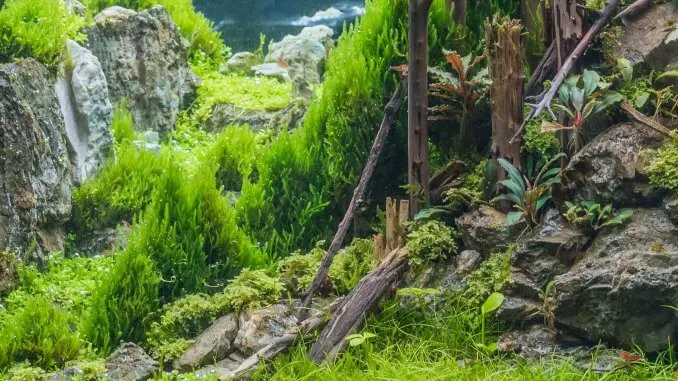
To many people, setting up and stocking a new tank can bring a sense of enjoyment and fulfillment as you watch it progress.
Aquascaped tanks are some of the most beautiful within the aquarium hobby.
They are often the highlight of any aquarist’s collection and are even entered into yearly competitions.
In our complete guide below we will share with you what it takes for you to begin your journey into aquascaping – with a hope that one day you can master this art form.
We will cover everything you need to know from equipment, to types of aquascapes and setup advice.
What is Aquascaping?
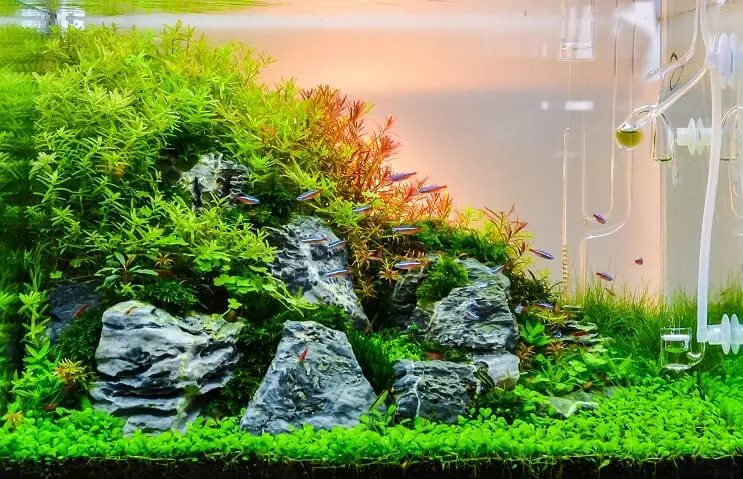
Aquascaping is the skill of laying out aquariums, ponds, or lakes with hardscapes like rocks, stones, and wood, as well as species of plants.
They are a form of aquatic gardening and there are lots of different aquascape types. These range from simple to complex with some taking many years to perfect.
There are lots of variables that need to be taken into consideration when working on an aquascape.
Some aquarists spend months drawing up designs for their next venture. However, the layout is not all that needs to be taken into consideration, even though the primary objective is to create a peaceful underwater landscape.
Behind the scenic arrangement, a lot of thought also goes into the kind of filtration which will be used as well as how to support photosynthesis and plant growth.
Lighting is also a key factor that needs to be addressed as light is essential for the growth of plants within the aquarium. The lighting however also promotes the growth of unwanted algae.
Maintaining the tank can be quite challenging, especially when dealing with algal growth.
To combat algae, aquarists also add different organisms like shrimp and fish which will eat the algae.
Types of Aquascapes
There are many different types of Aquascapes, but 3 types in particular have become the most popular.
Natural Aquascape

This form of aquascaping is also known as the nature style and it was first introduced by Takashi Amano in the late 20th century. It sets out to mimic natural landscapes within the aquarium using rocks or driftwood as the centerpiece.
It very much resembles Japanese style gardens which aim to create a peaceful ecosystem.
Very few species of plants are used in this style with most being either moss or carpeting plants. This style requires a lot of maintenance through trimming and frequent water changes.
Iwagumi Aquascape
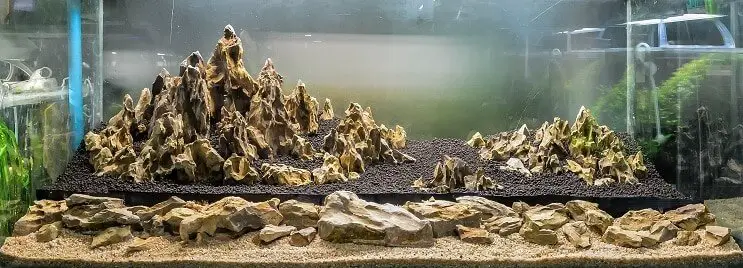
This is a type of natural aquascape and is Japanese styled. It mainly uses rocks to provide the main visual focus in the aquarium.
You will only see a few plants, usually just one or two carpeting species.
It is a very simplistic form of aquascaping as there are not a lot of elements which go into it. However, it can take years to become a master Iwagumi aquascaper.
The plants as well as the hardscapes are usually arranged in an asymmetrical style. The aim is to provide a sensation of peacefulness and calmness and it should only contain few small fish.
Dutch Aquascape

This form of aquascape is taken from the popular flower and plant arrangement culture in Holland. It works by placing a colorful contrast of different shaped plants into large beds and terraces as well as rows.
The style is most commonly used in large aquariums due to the fact that many different species are being used and it requires a lot of space.
Contrary to the Iwagumi and Natural styles, the Dutch style does not use ornaments like wood or rocks, and instead relies solely on plants. A thick carpet of plants is vital.
How to Aquascape
Step 1: Planning Your Layout
Before you begin you should try to get an idea of the size of the aquarium you want to use as well as the style you would like to reproduce.
Try and think of what the final design will look like as well as the types of hardscapes like rocks or wood. Also, consider the species of both fauna and flora which will inhabit the tank.
You will also need to plan the position of your aquarium.
Avoid placing the tank somewhere where it will get a lot of direct sunlight as this will promote unwanted algae growth.
Also avoid any areas near heat sources as an increased temperature will have the same effect. Somewhere cool and out of direct sunlight is ideal.
Step 2: Choosing and Adding Substrate
This will depend on what style of aquascaping you want to follow. General sand and gravel will play no part in plant growth – for this, soil works best.
Try to find a soil which has a high nutrient content and that will maintain a neutral or slightly acidic pH to promote healthy plant growth.
Before adding the soil to the aquarium, you should first place a lava granulate base. This will act as a stable support for large stones, as well as providing gaps to loosen the soil and allow for nutrient and water circulation.
Once this is done, you can add the soil in the specific layout which you designed.
Step 3: Hardscaping
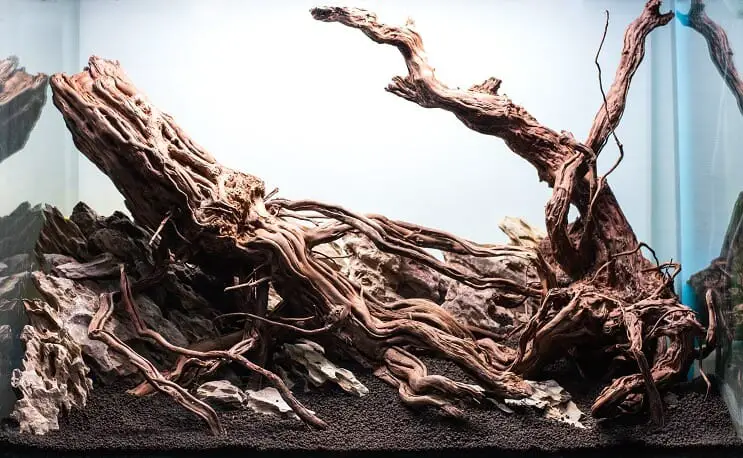
Once again, the choice of the type of hardscape will depend on the type of setup you are trying to complete. Hardscapes are primarily made up of rock, stones, driftwood or bogwood.
Lay them out in the manner of your choice but be sure that they are stable and will not slip when you add water as you don’t want to crack or break the glass in the tank.
Step 4: Planting the Aquarium
Plants should be placed into the substrate using tweezers and should be pushed down about an inch into the soil to prevent them from breaking loose and detaching.
Step 5: Adding the Water
The water should be added carefully so as not to displace the substrate.
There are a few methods you can use. Firstly, you could choose to place a small bowl on top of the substrate and gently pour water in. You could also choose to fill the aquarium slowly using a very thin siphon.
Step 6: Cycle the Aquarium
Allow up to 6 weeks for the aquarium to complete the nitrogen cycle.
This allows for the development and growth of beneficial bacteria which aid in converting ammonia and nitrites which can kill any fish you place in the tank.
Step 7: Choosing and Adding Fish
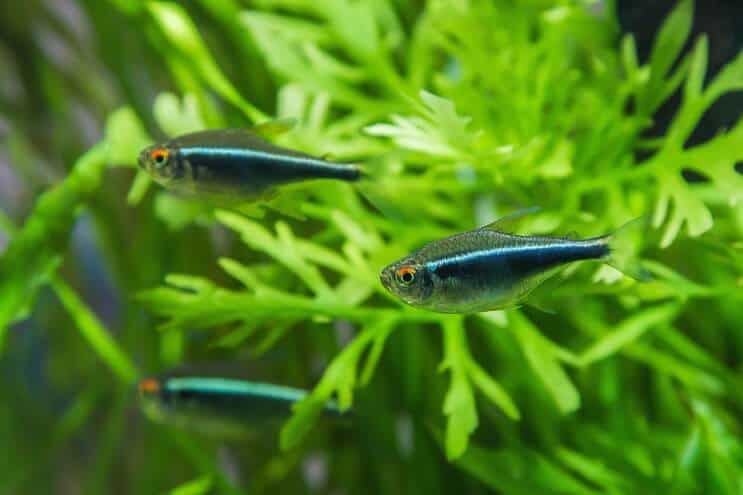
The species you choose to add is totally up to you, just be sure to only add fish that are not going to get too large for the aquarium.
When you are ready to add the fish, it is vital that you don’t just dump them straight in. Instead, allow for them to acclimatize to the water conditions.
This can be done by placing the bag they came in into the tank for about 10 minutes and after this period slowly add small cup sized quantities of tank water to the bag every 5 minutes until it is full. At this point you may release them into the tank.
Aquascape Equipment
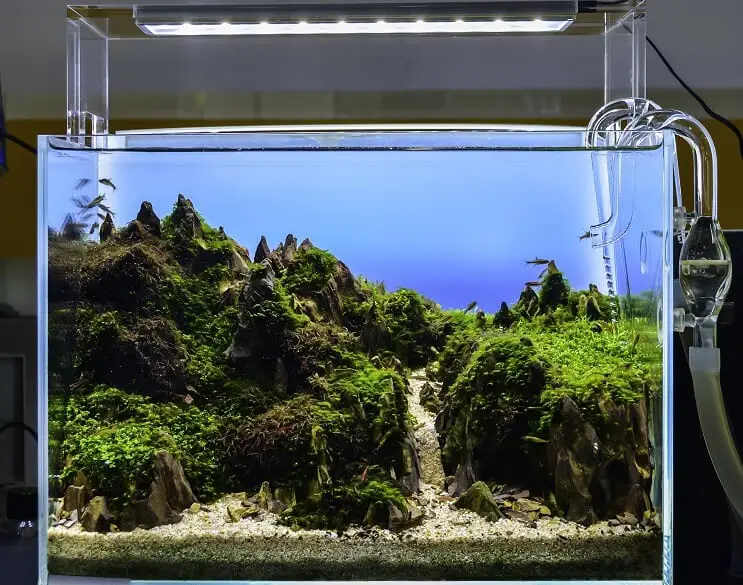
Regardless of the style you pick, there are certain pieces of equipment that are essential.
Lighting
Lighting is essential for maintaining a healthy ecosystem – it is needed for plant photosynthesis and growth.
The lighting must reflect around 6,500 Kelvin.
There are three different types of lighting setups that are suitable for planted aquariums.
- T5 fluorescent bulbs – They provide a nice range of light but can be a bit expensive and are less efficient than LED lights.
- LEDs – These are our preferred choice and are highly efficient. LEDs can last for as long as 50,000 hours and have minimal heat emission.
- Metal halides – They are extremely inefficient and can get very hot, however they are a good option for deeper aquariums.
Aquascape Pumps
There are two types of pumps that can be used in these setups.
The first type is an air pump which provides the aquarium (or pond) with an essential source of dissolved oxygen. They can also be used to create underwater sand/gravel waterfalls.
Water pumps are the second type that can be used. These pumps are generally used in outdoor ponds to create waterfall effects.
Substrate
There are a few substrates to choose from when aquascaping.
The most common substrate for planted aquariums is soil – this provides essential nutrients for healthy plant growth.
Gravel and sand are also used but this is mostly for their visual appearance as they come in various colors and sizes.
CO2 and Fertilizers
Carbon dioxide (CO2) is a vital component for the photosynthetic growth processes of all plants (including the ones in your aquariums). There are two ways of adding CO2 to your aquarium: liquid or gas injection.
Pressurized CO2 gas injection systems can be expensive, but they are efficient for maintaining the concentration of CO2 at around 10-15ppm (which is the ideal figure). Yeast and aerosol methods are generally less efficient and only useful for smaller aquariums.
Liquid Carbon fertilizers do not provide CO2 as efficiently compared to gas injection. This results in slower plant growth, so it is more commonly used in smaller aquariums.
Ornaments
For aquascaping, there are two main types of ornaments: wood (bogwood or driftwood) and rocks.
There are many different kinds of rocks which are safe to use within the aquarium.
The type of ornaments used will vary with the type of setup (more on this later).
Aquascape Ideas
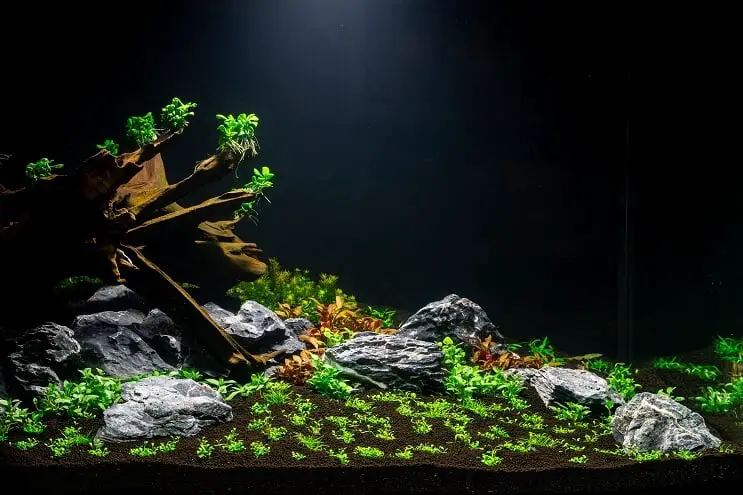
Usually aquascapers tend to take inspiration from the things they see day to day in nature or
from other tanks.
Sometimes it can take a long time to come up with an idea, so below we have a few examples to help get you started.
Waterfall
An aquascape waterfall is not flowing water that runs down off rocks and into the tank. In fact, it’s not water at all but instead, it is small sandy gravel that runs out of a rocky centerpiece and falls back to the bottom of the aquarium. This mimics a natural landscape waterfall.
This waterfall effect can be made by using a piece of piping with an air pump at the bottom and a hole for the gravel to fall into the tube.
Once in the tube, the grains of sand will be blown up through the tube by the air bubbles and be pushed out of the top with a U-shaped bend pointing back towards the substrate.
They will sink back to the bottom of the tank and the process is repeated. All that is left to do then is cover it with rocks and sit back and watch it flow.
Pools
Aquascape pools are usually made in paludariums (a tank that comprises both terrestrial and aquatic life).
Some paludariums have a large amount of terrestrial planted areas with only a small pool of water which can mimic bogs, rainforest pools or small streams.
They can be created by adding a substrate stop to the base of the aquarium to separate the false bottom of the terrestrial part from the aquarium soil substrate.
Place a substrate barrier to the terrestrial side before adding the substrate and plants. Then plant the aquatic plants in the pool section before adding the water and inhabitants.
Rocks
Aquascaping often uses rocks or stones as the focal point of the aquarium. There are numerous different types that can be used, and they can vary in price.
The type of style you choose will depend on how you will layout rocks and stones within the aquarium.
Iwagumi style mainly uses rocks as the only hardscape within the tank. Rock like Pagoda or Seiryu Ryuoh stone, are safe to use in the aquarium and are often arranged in elaborate pattern.
Betta Aquascape
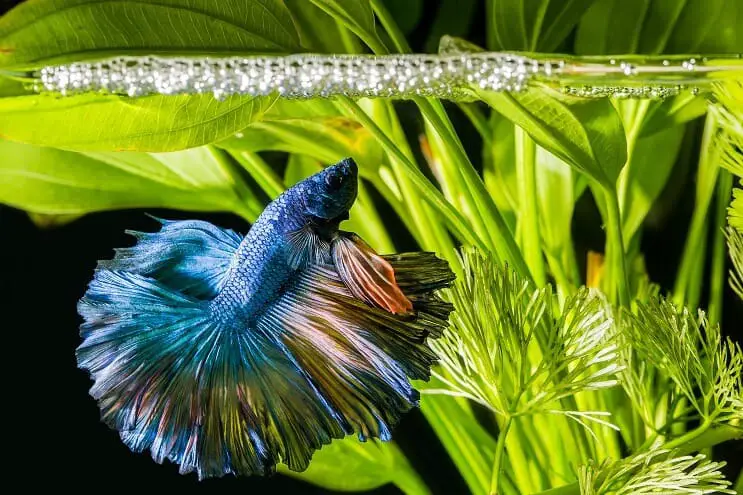
Betta tanks are a popular choice for aquascaping. If this is the tank for you then it can be arranged with a centerpiece of bog or driftwood. The substrate can be soil that can be planted with certain plant species like Anubias.
Other species like Needle Leaf Java Fern or Christmas Moss can be attached to the driftwood to create a more natural look.
A plant like Rotala Green can be added to the background of the tank. A floating species like Amazonian Frogbit can also be added to provide shaded areas and help reduce algae.
Best Plants for Aquascaping
There are many different types of plants that can be used for aquascaping. As well as being visually pleasing, they are also proven to provide a form of filtration, shelter for fish as well as helping to combat algae growth.
Carpeting plants are planted into the substrate and in the correct conditions will form a lush green carpet along the bottom of the aquarium.
The most commonly used carpeting plants include Dwarf Baby Tears, Dwarf Hairgrass, Marsilea minuta, Glossostigma elatinoides and Marsilea hirsute.
Floating plants can provide shelter as well as helping to provide partial shade which helps to fight against unwanted algae growth. Species like Amazon Frogbit, Dwarf Water Lettuce, Water Spangles and Duckweed are ideal.
Mosses are some of the most commonly used species. As well as species like Christmas Moss, Pellia Liverwort, there are also carpeting species like Java Moss and Crystalwort, and a floating species called Floating Moss.
Plants like Anubias, Amazonian Swords, Ludwigia repens and Jungle Vallisneria are all great options for background plants.
Nano Aquascape
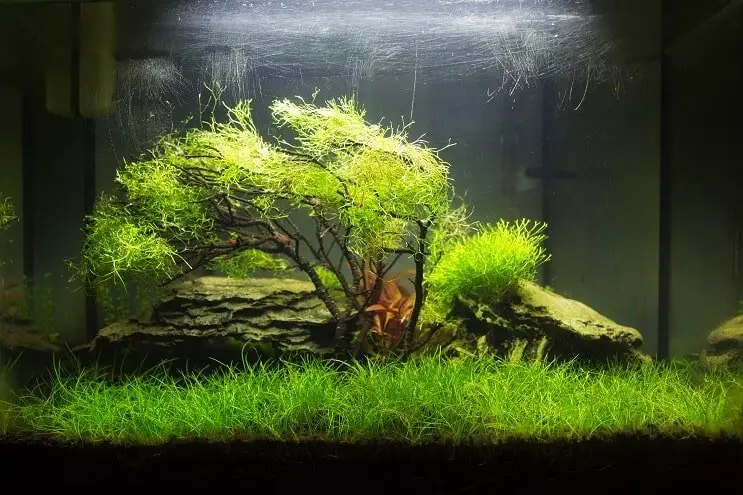
A nano aquarium is a tank that holds 10 gallons or less in volume.
Setting up a nano aquascape can be both fun and challenging at the same time – let’s look at the two most popular nano aquascapes.
10 Gallon Aquascape
Before you start, you should have an idea of what you want the 10-gallon aquarium to look like when you are finished.
For example, you may choose to add lava rock as a stable base and soil substrate to optimize plant growth. With this in place you could place a Seiryu Ryuoh stone centerpiece to the tank.
Around the rocky center and within the earthy substrate, add some plants like Java Moss or Dwarf Baby Tears which over time will grow across the floor of the tank to form a lush green carpet.
Lighting the aquarium should be done artificially with LED lights as tanks that are placed near windows will be more prone to algae growth.
Small shoaling fish like zebra danio and neon tetra would be ideal for a tank of this size.
5 Gallon Aquascape
The same principle applies with a 5-gallon fish tank, however, you may want to go for a more simplistic layout.
As the 5 gallon is more limited on space you may want to add smaller species of fish like Rice Fish or killifish or even some non-fish inhabitants like cherry shrimp or Ghost Shrimp which will aid in algae control.
However, lighting should be provided using LEDs and the tank should avoid direct sunlight to prevent algae growth.
Summary
There are many different types of aquascapes, and they range from relatively simplistic and peaceful to complex ones which take years to perfect.
This hobby requires lots of tank maintenance to ensure healthy habitats. This can be done by trimming overgrown plants, as well as regular water changes.
Aquascaped aquariums provide the perfect habitats for small shoaling fish and species like scarlet badis as well as shrimp.
What is your favorite aquascape style? Let us know in the comments section below…

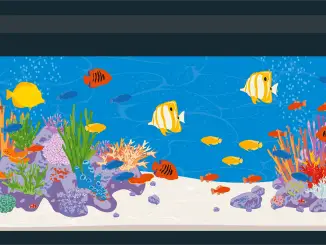
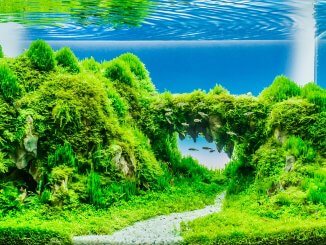
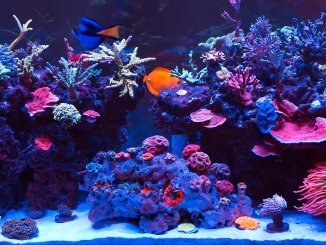
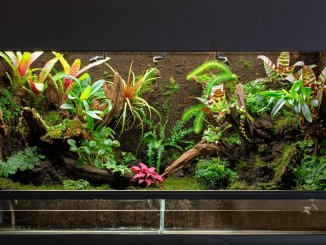
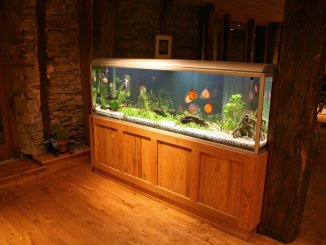

Thank you for an informative,and delightfully eye-appealing site. I am interested in finding a paint, or clear-coat I can apply to wood, or other articles which can be placed into an aquarium. Is there a specific clay I can use to create my own “wood” decorations?
I would appreciate any suggestions.
Mike
Hi Mike, I’ve never tried to create my own clay wood decorations, but I’ll leave you message here in case anyone else has any experience of this. With regards to a sealant, anything that is food safe can be assumed to be safe for your tanks, so perhaps have a look for a sealant which is used for ceramics. Thanks, Robert